Updated: AOpen MiniPC – Imitation is the Sincerest Form of Flattery
by Jarred Walton on March 3, 2006 12:05 AM EST- Posted in
- Systems
System Benchmarks
We'll start with the most likely usage scenario, general office and system performance. PCMark 04 and 05 were run along with Winstones 2004. Note that both PCMark versions run some 2D and 3D tests, so the IGP will factor into those scores. The AOpen MZ855 could only complete PCMark04 due to the Intel Extreme 2 integrated graphics.
This is basically what we've come to expect from Pentium M systems. It comes out the slowest of all the tested systems, but even dual core Pentium D systems aren't much faster in business tasks. The fact is that the MiniPC does fine in office tasks - it's up to 35% slower than the A64 4000+, but you'll seldom notice. However, the MiniPC struggles a bit in multimedia tasks and is almost half as fast as the 4000+; in many multimedia tasks you will notice the difference. It's doubtful that anyone would really buy this box with the intention of doing lots of video editing, but it can still best most three-year-old PCs in just about every office-related task. The 2.5" 5400 RPM hard drive also has an impact on overall performance, but it's really not too bad compared to the old 4200 RPM drives from a couple years ago.
The Futuremark products show a bit larger spread, and 3DMark scores are almost superfluous for the test systems. Real games might be able to run on some of the IGP solutions out there, but the demanding titles will often struggle to get playable frame rates even at 640x480 with minimal detail settings. Half-Life (the original) did run quite well on all of the systems at 800x600 and even 1024x768 in some cases, but that's about as far as you'd want to go.
Notice also how much of an impact the 6600 GPU has on the Sempron system: we would rate the 3100+ as being slightly slower than the PM 740 overall, and definitely slower than any of the other tested CPUs in overall performance. However, the fastest systems that we tested with the best IGP solutions currently available are still completely dominated by one of the slowest shipping processors around, once you add in a moderate GPU. Does this mean that the MiniPC (or any of the other systems) aren't worth having? Of course not, provided that 3D/gaming isn't a requirement.
We'll start with the most likely usage scenario, general office and system performance. PCMark 04 and 05 were run along with Winstones 2004. Note that both PCMark versions run some 2D and 3D tests, so the IGP will factor into those scores. The AOpen MZ855 could only complete PCMark04 due to the Intel Extreme 2 integrated graphics.
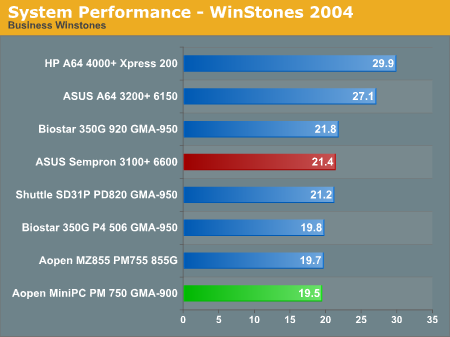
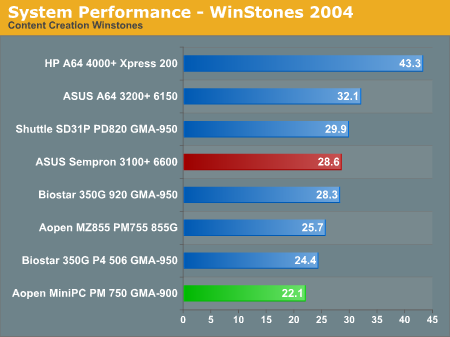
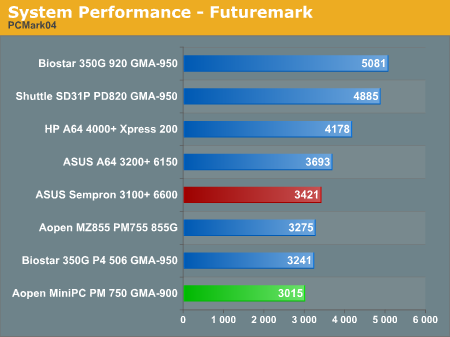
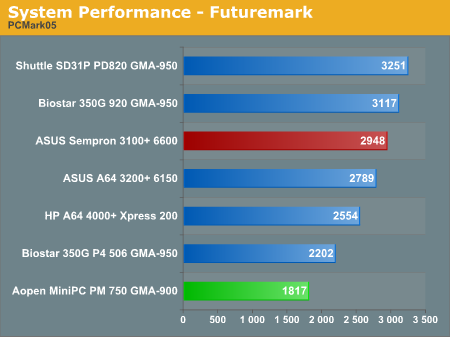
This is basically what we've come to expect from Pentium M systems. It comes out the slowest of all the tested systems, but even dual core Pentium D systems aren't much faster in business tasks. The fact is that the MiniPC does fine in office tasks - it's up to 35% slower than the A64 4000+, but you'll seldom notice. However, the MiniPC struggles a bit in multimedia tasks and is almost half as fast as the 4000+; in many multimedia tasks you will notice the difference. It's doubtful that anyone would really buy this box with the intention of doing lots of video editing, but it can still best most three-year-old PCs in just about every office-related task. The 2.5" 5400 RPM hard drive also has an impact on overall performance, but it's really not too bad compared to the old 4200 RPM drives from a couple years ago.
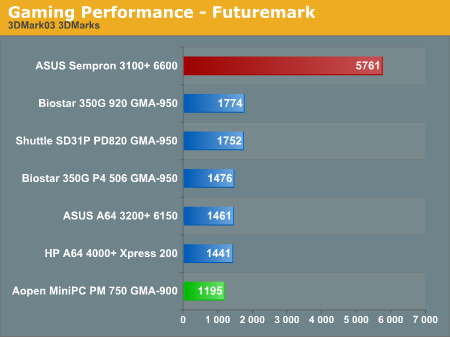
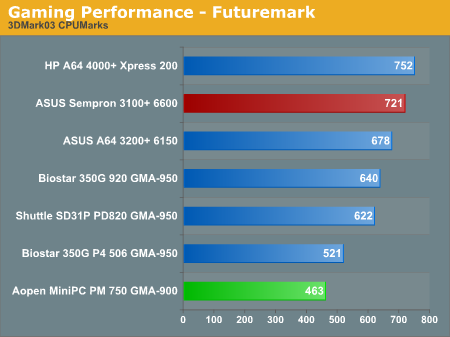
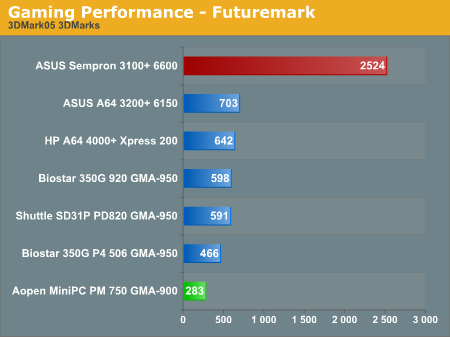
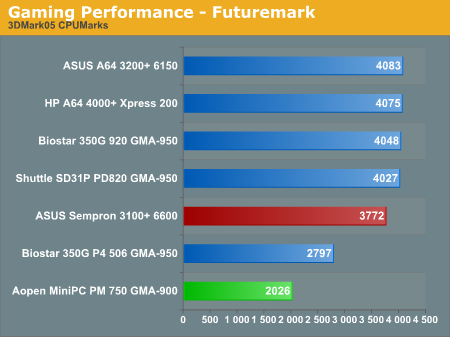
The Futuremark products show a bit larger spread, and 3DMark scores are almost superfluous for the test systems. Real games might be able to run on some of the IGP solutions out there, but the demanding titles will often struggle to get playable frame rates even at 640x480 with minimal detail settings. Half-Life (the original) did run quite well on all of the systems at 800x600 and even 1024x768 in some cases, but that's about as far as you'd want to go.
Notice also how much of an impact the 6600 GPU has on the Sempron system: we would rate the 3100+ as being slightly slower than the PM 740 overall, and definitely slower than any of the other tested CPUs in overall performance. However, the fastest systems that we tested with the best IGP solutions currently available are still completely dominated by one of the slowest shipping processors around, once you add in a moderate GPU. Does this mean that the MiniPC (or any of the other systems) aren't worth having? Of course not, provided that 3D/gaming isn't a requirement.










54 Comments
View All Comments
davecason - Friday, March 17, 2006 - link
Just an FYI for the reviewer: use tweezers. The plastic inner shell is designed for tweezers with an angled grip point. There are both cut-outs and spaceous slotting to accomodate tweezers on every screw installation.Did anyone pick up one of these and have trouble with the IDE PCB? I have two problems: 1) DMA turns itself off and the drive resorts to PIO mode when I attach it through to the PCB. I have tested the drive elsewhere and on the USB bus and it runs at normal speeds but when it is attached internally it slows down to about 1/10 of the speed. Removing the optical drive from the PCB has no affect on the problem.
2) The system hiccups when I boot it. The optical drive goes into a long series of IDE bus restarts and if I remove it, the IDE drive simply takes forever to boot (probably because of some bus error and the speed is being backed down to almost nothing).
Any suggestions for that?
davecason - Tuesday, March 28, 2006 - link
The IDE bus was restarting itself due to a power problem. I had the following plugged into the USB bus:1) USB Keyboard with USB hub with a USB mouse plugged into it.
2) USB bus-powered hub with a self-powered PDA base and a UPS plugged into it.
I removed #2 and the IDE bus began functioning normally. I guess four/six items on the USB bus was too much power draw from the system. If you experience this, get a self-powered USB hub.
Plugers - Saturday, March 4, 2006 - link
On the next revision.Add a upgradable laptop video card slot. If laptops can get a nice small Nvidia / ATI solution, why not this? Also add the other audio port, or just add a toslink for HTPC use and I think most of the high end PC sound systems have a digital input option anyway.
throw in another sodimm slot while your at it....
bldckstark - Saturday, March 4, 2006 - link
I am glad to see that for once there are not many whiny posts about the comparison systems. Thanks for the inclusion of the Sempron system.Kishkumen - Saturday, March 4, 2006 - link
Actually my interest with these Mini PCs whether Aopen or Apple is to use them as a lightweight frontend to a Linux/MythTV HTPC with storage and encoding duties relegated to a master backend and better yet no need to whine about the additional cost of an OS. The mini is small enough that it can be easily attached to the back of a plasma or LCD for a very clean look. That said, Aopen's audio solution is absolutely tragic. I really don't understand how they thought they could skimp in this area even if they were completely unaware of it's potential as a HTPC solution. At the very least a digital optical connector should have been included. Thus I'm inclined to go with the Apple solution on the audio issue alone, but in general it seems like the better hardware and I have no reason to believe I can't run Linux on it just fine. I'll be paying for an OS I don't need but maybe I can just pawn it off on ebay or I'll just keep it around for the halibut. Something to gape at once in a while like a two headed snake in a jar at the circus.JarredWalton - Saturday, March 4, 2006 - link
Does Linux run on EFI okay? I don't have any idea. It's certainly a lot more likely than XP on EFI. Anyway, the MP945 is supposed to go with at least 5.1 audio I think.mindless1 - Saturday, March 4, 2006 - link
PLEASE, quite trying to pretend Apple is some kind of leader in form factor. no, it was not the MAC cube that started SFF. This AOPEN is not imitation anything either. Did you really think the entire computer world was NOT moving towards high integration and as-small-as-possible systems?It had absolutely nothing to do with Apple. Apple merely did the same as everyone else, sometimes coming up with a particular niche product sooner than others, and sometimes later than others. The one most noteworthy thing apple did was advertising.
How about the ipod? It wasn't first either. Good grief, why in the world do you have an arbitrary false conclusion that apple was first at much of anything?
That's not to downplay Apple's influence, they did add a certain esthetic appeal, more artistic cases on many products. That's not what was implied in the article though...
JAS - Monday, March 6, 2006 - link
Just a general comment:MAC = Media Access Control, as in a computer's Ethernet address
Mac = shorthand for Macintosh
JarredWalton - Saturday, March 4, 2006 - link
By your reasoning, Apple was first at nothing, and the only first was probably the ENIAC. After all, we've just been moving to smaller computers for over 60 years now.... Seriously, there is no way you can convince me that the AOpen MiniPC wasn't an attempt at copying the Mac Mini design. Was the Mac Mini completely original? Maybe someone had something like that before, but they're the ones that really put the "Mini" computers on the map.Anyway, how about some comparisons from AOpen - nice pictures, and they clearly show that any resemblance to the Mac Mini is likely more than coincidence.
http://images.anandtech.com/reviews/system/sff/aop...">MiniPC vs. Mac Mini #1
http://images.anandtech.com/reviews/system/sff/aop...">MiniPC vs. Mac Mini #2
http://images.anandtech.com/reviews/system/sff/aop...">MiniPC vs. Mac Mini #3
http://images.anandtech.com/reviews/system/sff/aop...">MiniPC vs. Mac Mini #4
http://images.anandtech.com/reviews/system/sff/aop...">MiniPC vs. Mac Mini #5
psychobriggsy - Saturday, March 4, 2006 - link
The Mac Mini looks better, both in terms of looks and design (e.g., the back panel looks so much better). If you're gonna copy a design, at least try and make it look even better if you're not going to compete on price...